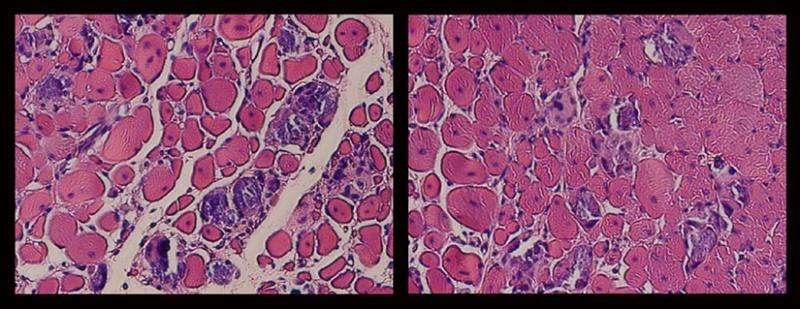Newfound strength in regenerative medicine

Researchers in the field of mechanobiology are evolving our understanding of health by revealing new insights into how the body's physical forces and mechanics impact development, physiological health, and prevention and treatment of disease. At the Wyss Institute for Biologically Inspired Engineering at Harvard University, engineers and biomedical scientists have assembled to form collaborative teams that are helping to drive this exciting area of research forward toward real-world applications. Now, a new study suggests mechanically-driven therapies that promote skeletal muscle regeneration through direct physical stimulation could one day replace or enhance drug and cell-based regenerative treatments. Discovered by a team at the Wyss Institute and the Harvard School of Engineering and Applied Sciences, the finding was published on January 25 in the journal Proceedings of the National Academy of Sciences.
"Chemistry tends to dominate the way we think about medicine, but it has become clear that physical and mechanical factors play very critical roles in regulating biology," said Harvard bioengineer David Mooney, Ph.D., senior author on the new study, who is a Wyss Institute Core Faculty member and the Robert P. Pinkas Family Professor of Bioengineering at the Harvard John A. Paulson School of Engineering and Applied Sciences (SEAS). "The results of our new study demonstrate how direct physical and mechanical intervention can impact biological processes and can potentially be exploited to improve clinical outcomes. "
The multi-disciplinary team spanning the Wyss Institute's Programmable Nanomaterials and Bioinspired Robotics platforms was led by Mooney and also included soft roboticist Conor Walsh, Ph.D., who is a Wyss Core Faculty member, Associate Professor of Mechanical and Biomedical Engineering at Harvard SEAS and Founder of the Harvard Biodesign Lab, and biomechanical engineer Georg Duda, Ph.D., who is a Wyss Associate Core Faculty member, Vice-Director of the Berlin-Brandenburg Center for Regenerative Therapies (BCRT) and the Director of the Julius Wolff Institute for Biomechanics and Musculoskeletal Regeneration at Charité-Universitätsmedizin Berlin.
In humans, up to half of body mass is made up of skeletal muscle, which plays a key role in locomotion, posture, and breathing. Although skeletal muscles can overcome minor tears and bruising without intervention, major injuries commonly caused by motor vehicle accidents, other traumas, or nerve damage can lead to extensive scarring, fibrous tissue, and loss of muscle function.
The team applied combined murine models of muscle injury and hind limb ischemia to investigate two potential mechanotherapies: an implanted magnetic biocompatible gel and an external, soft robotic pressurized cuff. To alleviate severe muscle injuries, the team implanted a magnetized gel called a "biphasic ferrogel" so that it would be in direct contact with the damaged tissue. Another experimental group of mice did not receive the ferrogel implant, but instead were fitted with a soft robotic, non-invasive pressurized cuff over the injured leg. Then, the ferrogel was subjected to magnetic pulses to apply cyclic stimulation to the muscle, while pulses of air allowed the cuff to cyclically massage the hind leg. Both groups received two weeks of localized mechanical perturbation using the two distinct methods.
The researchers discovered that cyclic mechanical stimulation provided by either magnetized gel or robotic cuff both resulted in a two-and-a-half-fold improvement in muscle regeneration and reduced tissue scarring over the course of two weeks, ultimately leading to an improvement in regained muscle function and an exciting new finding that mechanical stimulation of muscle alone can foster regeneration. To their surprise, the ferrogel implant and pressurized cuff also resulted in very similar levels of regeneration, suggesting that the use of non-invasive pressurized cuffs or devices could one day help heal patients suffering from severe muscle injuries.
"Until now most approaches to muscle regeneration have been biologic, relying on the use of drugs or cells," said Christine Cezar, Ph.D., lead author on the study who completed her doctoral research at the Wyss Institute and Harvard SEAS. "Our finding that mechanical stimulation alone is enough to enhance muscle repair could open the door to new non-biologic therapies, or even combinatorial therapies that employ both mechanical and biological interventions to treat severely damaged skeletal muscles."
The direct stimulation of muscle tissue increases the transport of oxygen, nutrients, fluids and waste removal from the site of the injury, which are all vital components of muscle health and repair. And according to Mooney, one of the most exciting aspects of this research is that its translation to the clinic in the form of a stimulatory device could be relatively rapid as compared to drug or cell therapies.
Down the road, the principle of using mechanical stimulation to enhance regeneration or reduce formation of scarring or fibrosis could also be applied to a wide range of medical devices that interface mechanical components with body tissues. Currently, clinical devices are often plagued by the formation of thickened tissue capsules that form at the intersection of machine and man. The team plans to explore how the findings can make the jump from the laboratory to the clinic.
"This work clearly demonstrates that mechanical forces are as important biological regulators as chemicals and genes, and it shows the immense potential of developing mechanotherapies to treat injury and disease," said Wyss Institute Founding Director Donald Ingber, M.D., Ph.D., who is a pioneer and leader in the field of mechanobiology. Ingber is also the Judah Folkman Professor of Vascular Biology at Harvard Medical School (HMS) and the Vascular Biology Program at Boston Children's Hospital, as well as Professor of Bioengineering at Harvard SEAS. "The challenge now is to advance this new mechanotherapeutic approach from the bench to bedside, where the real impact on human lives can occur."
More information: Biologic-free mechanically induced muscle regeneration, www.pnas.org/cgi/doi/10.1073/pnas.1517517113



















